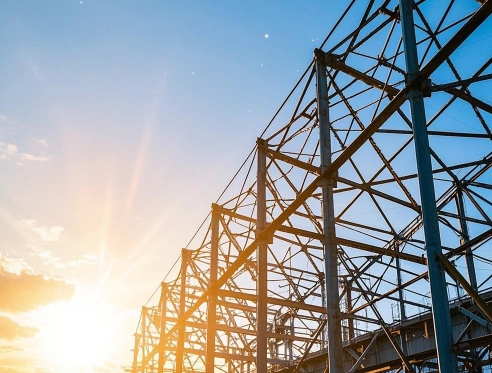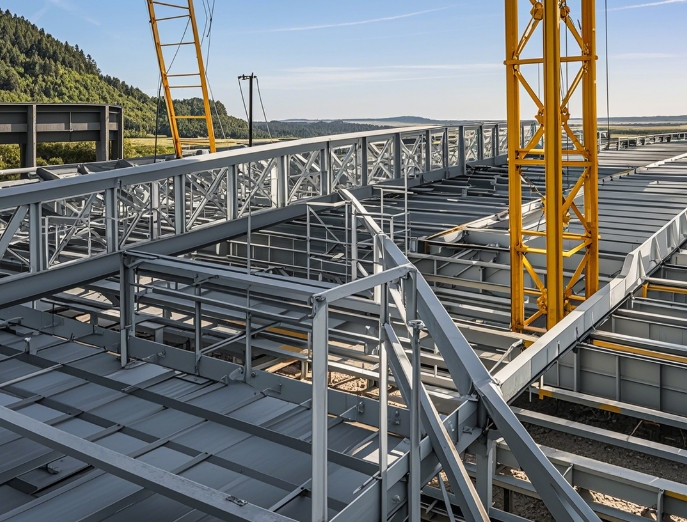Full analysis of grid processing and assembly methods
更新时间:2025-02-19 15:19:08•点击:154052 • Entreprise's news
In modern construction engineering, grid structures are widely used due to their unique advantages, such as sports halls, exhibition halls, large factories, etc. The assembly method of grid processing has a crucial impact on the quality, stability, and construction efficiency of the entire grid structure. Below, we will provide a detailed introduction to several common methods of processing and assembling grid structures.
Welding assembly
Welding is a common method of assembling grid structures. It melts and fuses the metal at the steel connection point through high temperature, forming a strong overall connection. The advantages of welding assembly are very obvious, with high connection strength and the ability to withstand large loads, making the grid structure more stable. At the same time, the welded nodes have good overall integrity and strong sealing. For some buildings that require high structural integrity and waterproofing, such as the roof truss of a swimming pool, welding and assembly is a good choice. However, welding also has certain drawbacks. During the welding process, high temperatures are generated, which can easily cause local deformation of the steel and affect the accuracy and appearance quality of the grid structure. Moreover, welding quality requires a high level of technical proficiency from welders. If welding is not done properly, welding defects such as porosity and cracks may occur, reducing the safety of the structure.
Bolt connection assembly
Bolt connection is the use of bolts to connect the various components of the grid together. This assembly method has the advantage of fast installation speed. At the construction site, workers can quickly assemble the components through bolts, greatly shortening the construction period. In addition, bolt connections are easy to disassemble and replace components. If a component of the grid structure has a problem during use, it can be easily repaired or replaced. Meanwhile, bolted connections have relatively low requirements for the construction environment, unlike welding which requires specific welding equipment and conditions. However, bolted connections are not perfect either. Due to the fact that bolt connections transmit loads through friction, bolts may become loose during long-term use due to factors such as vibration and temperature changes, requiring regular inspection and tightening.
Rivet connection assembly
Rivet connection is the process of inserting rivets into the nail holes of the connected component, and forming a firm connection between the rivets and the connected component through riveting. The advantage of rivet connection is that it is reliable and can withstand large shear and tensile forces. In some heavy-duty industrial buildings with extremely high structural strength requirements, rivet connection plays an important role. Moreover, rivet connections have good fatigue resistance and are suitable for structures that can withstand repeated loads. However, the construction process of rivet connection is relatively complex and requires specialized riveting equipment, resulting in relatively low construction efficiency. Moreover, during the riveting process, there may be some damage to the surface of the component, which requires subsequent treatment.
Different methods of processing and assembling grid structures have their own advantages and disadvantages. In practical engineering, it is necessary to comprehensively consider specific engineering requirements, structural characteristics, construction conditions, and other factors to select the most suitable assembly method to ensure the quality and safety of the grid structure, while improving construction efficiency and reducing project costs.
Welding assembly
Welding is a common method of assembling grid structures. It melts and fuses the metal at the steel connection point through high temperature, forming a strong overall connection. The advantages of welding assembly are very obvious, with high connection strength and the ability to withstand large loads, making the grid structure more stable. At the same time, the welded nodes have good overall integrity and strong sealing. For some buildings that require high structural integrity and waterproofing, such as the roof truss of a swimming pool, welding and assembly is a good choice. However, welding also has certain drawbacks. During the welding process, high temperatures are generated, which can easily cause local deformation of the steel and affect the accuracy and appearance quality of the grid structure. Moreover, welding quality requires a high level of technical proficiency from welders. If welding is not done properly, welding defects such as porosity and cracks may occur, reducing the safety of the structure.
Bolt connection assembly
Bolt connection is the use of bolts to connect the various components of the grid together. This assembly method has the advantage of fast installation speed. At the construction site, workers can quickly assemble the components through bolts, greatly shortening the construction period. In addition, bolt connections are easy to disassemble and replace components. If a component of the grid structure has a problem during use, it can be easily repaired or replaced. Meanwhile, bolted connections have relatively low requirements for the construction environment, unlike welding which requires specific welding equipment and conditions. However, bolted connections are not perfect either. Due to the fact that bolt connections transmit loads through friction, bolts may become loose during long-term use due to factors such as vibration and temperature changes, requiring regular inspection and tightening.
Rivet connection assembly
Rivet connection is the process of inserting rivets into the nail holes of the connected component, and forming a firm connection between the rivets and the connected component through riveting. The advantage of rivet connection is that it is reliable and can withstand large shear and tensile forces. In some heavy-duty industrial buildings with extremely high structural strength requirements, rivet connection plays an important role. Moreover, rivet connections have good fatigue resistance and are suitable for structures that can withstand repeated loads. However, the construction process of rivet connection is relatively complex and requires specialized riveting equipment, resulting in relatively low construction efficiency. Moreover, during the riveting process, there may be some damage to the surface of the component, which requires subsequent treatment.
Different methods of processing and assembling grid structures have their own advantages and disadvantages. In practical engineering, it is necessary to comprehensively consider specific engineering requirements, structural characteristics, construction conditions, and other factors to select the most suitable assembly method to ensure the quality and safety of the grid structure, while improving construction efficiency and reducing project costs.
Recommended Reading
-
Full analysis of seismic design and maintenance of grid structure
2025-02-27 16:16:52•1194764 次
-
What are the key process points to follow in order to ensure the quality of grid processing?
2025-02-27 11:21:00•115619 次
-
What type of construction is the grid mainly suitable for?
2025-02-25 16:42:00•111889 次
-
Quality control requirements of grid manufacturers!
2025-02-25 16:02:44•208056 次






